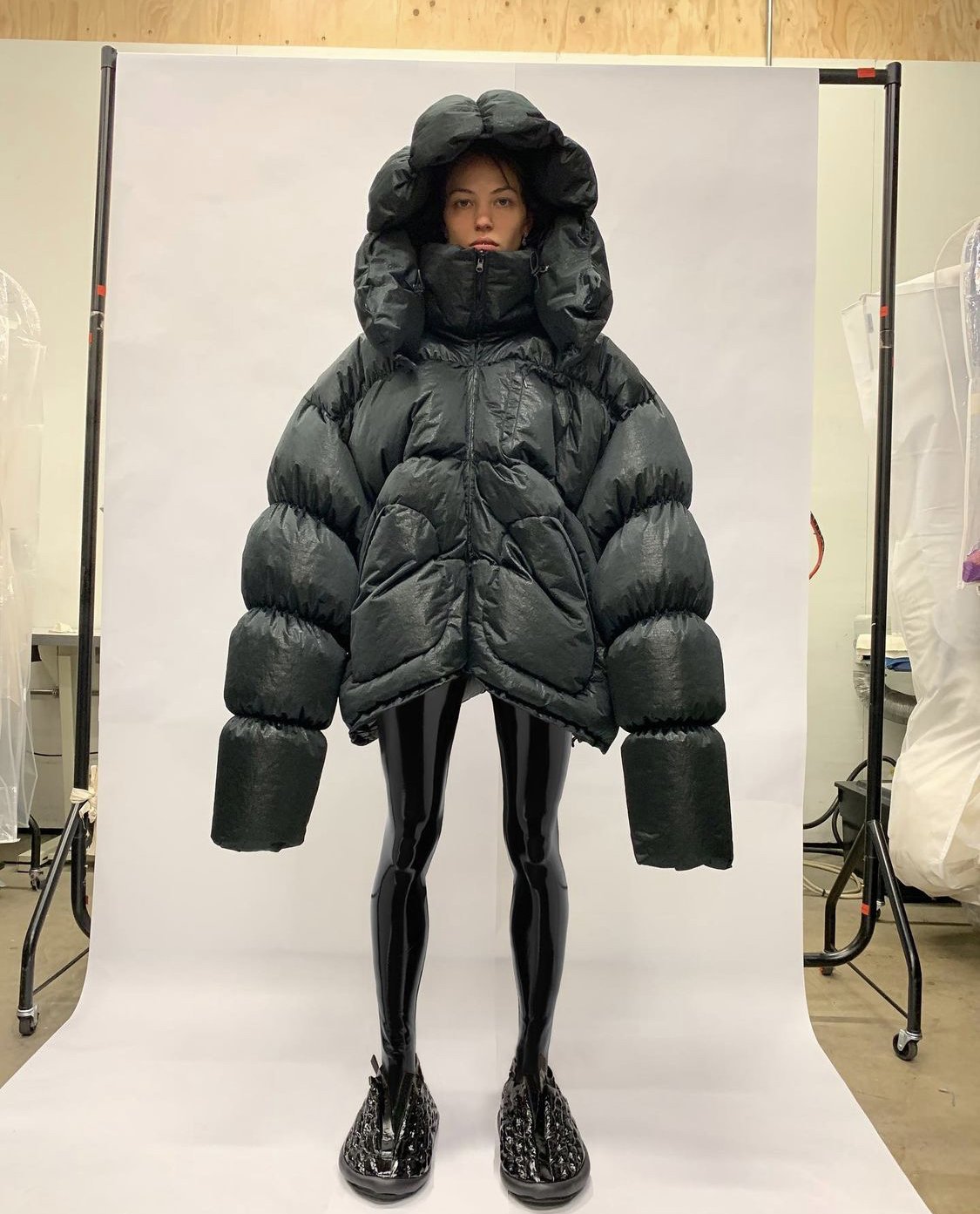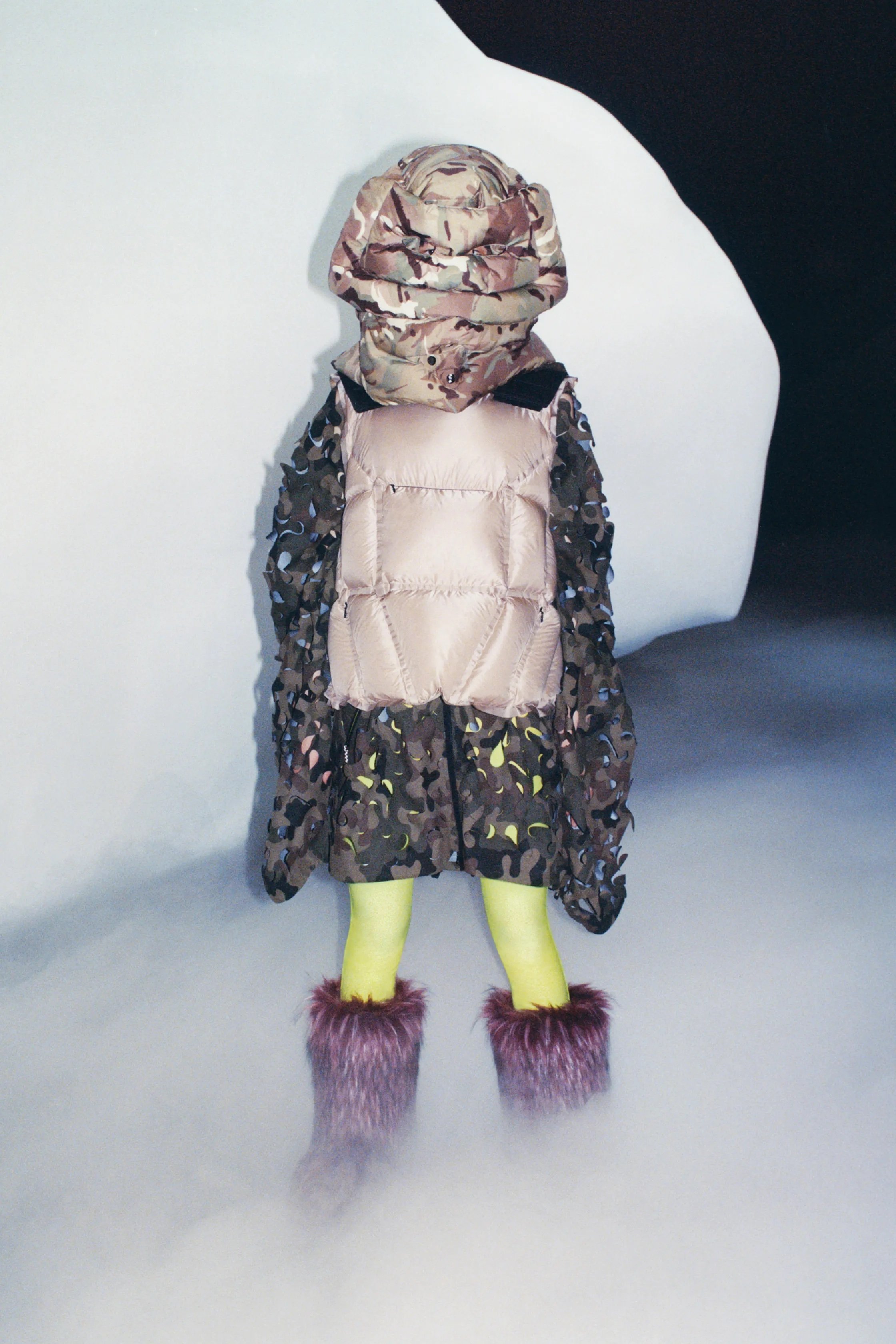Dingyun Zhang: A Functional Future for Fashion
If you haven’t heard the name Dingyun Zhang yet, there’s a good chance you’ve seen his work. With his anatomically abnormal silhouettes, the Chinese born designer has sent shock waves through the fashion world. From oversized down filled facemasks, to alien-like footwear, Zhang’s work has brought a flavour of futurism to the fashion world at a time where it needed it most.
Born in the small region of New Mongol, China, Dingyun Zhang grew up in Beijing. As a child, he already began to develop a keen interest in fashion, initially blossoming from his love for basketball footwear. At the time, basketball was becoming increasingly popular in China and Zhang recalls how he instantly was drawn to the Jordan and Kobe runners.
However, being a child at the time, Zhang couldn’t fit into the adult-sized sneakers and had no interest in the children’s versions which substituted the subtle details for size.
“I wanted the real ones, not the simplified kids versions. They felt fake because all those crazy details and fabrics were gone since shoes for adults are built differently.”
So, without his parents buying them for him, Zhang would spend his time collecting SIZE magazines, sketching sneakers in his schoolbooks, and even making sneaker trading cards to sell at his school instead.
At age 16, his love and appreciation for art and fashion had begun to mature. Inspired by painters such as Robert Rauschenberg and David Hockney, the young teen decided to study fine art, relocating to Summerset, England. It was here Zhang really began to experiment with photography and collage artwork in order to create his envisioned works.
“I would experiment with cutting up magazines and photography, to distort pictures and produce new imagery.”
This process can still be seen in the designers work as a template for many of his current designs and collections.
During his studies in England, Zhang’s growing love for fashion led him to read about the country’s renowned fashion college, Central Saint Martins, where he would eventually go on to study. After completing a one-year diploma in art and design, Zhang enrolled in a bachelor of fashion design at the college, where he quickly began to flourish.
He found a fascination with both the concepts of aesthetics and functionality, as well their respective relationship to each other within the fashion world. One book which Zhang cites as being a particular inspiration for his was Jackie Nickerson’s book of portrait photography Farm, which explores working people from rural farm areas of Zimbabwe, Malawi, Mozambique and South Africa.
Zhang was enthralled by the photographs and became fixated on the idea of functionality in clothing and how the purpose of the garments worn by the individuals photographed in Farm was purely purposeful, a significant contrast from how we see fashion in more developed countries.
Living in London, Zhang had also developed an increased interest in more sportswear brands such as Stone Island and CP Company which were popular amongst the people of London. These brands, while certainly being aesthetic and fashion-focused, also have a passionate culture around the types of materials, fabrics and processes used to make them.
Around this time, streetwear and fashion’s gradual merge into a more symbiotic relationship was also well underway. While this seemed to suit Zhang’s taste perfectly, a distaste for this change was also prevalent among streetwear naysayers. Zhang however saw the opportunity in this, reflecting how;
“Among the people in my class, streetwear was kind of stigmatized as a ‘fuccboi trend.’ I was the only one in the group trying to work with and elevate it.”
So, with all these multiple inspirations in the mix, Zhang began to really make his vision come to life.
During his second BA year at Saint Martin’s, Zhang’s work caught the attention of one of his tutors who decided to put him in contact with Kanye West. Upon seeing his work, Zhang’s talent was clear to West who resultantly brought him to Wyoming to design for Yeezy alongside design director Stephen Smith. Although this opportunity could have been daunting for many, Zhang states that he never felt in any way pressured in the position, explaining how;
“[Kanye] gave me the liberty and responsibility to express myself and working with him was a great experience that taught me a lot.”
This freedom really allowed him to come into his own and create pieces of unconventional and forward-thinking work, including the renowned 700 Wave Runner.
Following this, Zhang returned to Central Saint Martins for his final year and presented his graduate show. The show aimed to explore “the contrast between luxury culture and necessity” and demonstrates a heavy blend of his influences, from the rural portraits of Jackie Nickerson to Zhang’s more futuristic streetwear tastes. The collection featured a mixture of modern silhouettes constructed with functional and durable fabrics in an array of earthy tones which really demonstrated the designer’s formation and growth into a signature style.
The collection was made largely by hand, with garments having to be re-dyed multiple times due to the complexity of the fabrics used and patterns on the clothing being hand-stitched on in layers to add a focus to the idea’s texture and depth.
Following his BA at Central Saint Martins, Dingyun Zhang enrolled in a Masters's degree at the university. It is here where he gained a lot of widespread attention online with a collection that brought the previous functional aspects of his work down an almost extra-terrestrial avenue with exaggerated silhouettes that are equally as playful as they are haunting. The collection marries function with fashion, and plays with ideas of protection versus overprotection, taking all these concepts to such extreme levels as to make us question where one in fact merges into another. Face masks that appear to protect while simultaneously swallowing the wearer, and gargantuan puffers which appear as comfortable as they are impractical, the striking body of work leads us to question whether the garment is there to protect or consume the wearer.
Up until this point, while Dingyun Zhang was gaining significant recognition, he had actually not sold a single item of his own collection, stating that he wanted to plan every detail of his collection right down to the wash-tag with absolute precision and won’t sell anything until it’s absolutely perfect.
However, Zhang has also continued to expand and develop his work through numerous collaborations such as Birkenstock, Area, and most recently a Moncler Genius collection. This collection served as the perfect stage for Zhang to bring his unique vision to functional fashion, providing an outlet where he could put a fresh spin on something classic.
“I wanted to create a simultaneous clash and harmony between my construction ideas and Moncler’s traditional details”
Zhang states.
As a designer who also puts such a concerted focus into the materials used in his work, this collaboration also provided access to an array of fabrics which allowed his work to really come to life. Zhang employed Moncler’s signature colourings, materials and technologies and warped them in an effort to redefine these classic aesthetics to create something bold and new, using tradition to pave a new path.
The budding designer also wanted to reference various aspects of the natural world such as the signature mountains of the Moncler brand and various elements of underwater life. We can clearly see these influences in many of the looks such as the swaying seaweed resembling boots or the porous puffers which are reminiscent of coral reefs.
In February 2021, Zhang decided to finally launch his own clothing brand which again featured his exaggerated and elaborate silhouettes which have swept through social media feeds. However, forward-thinking design work is not the only focus that Dingyun Zhang has set his sight on, but also aims to create a more forward-thinking fashion industry as a whole.
One of Zhang’s main missions is to elevate the fashion industries’ ethics as a whole and their relation to the planet we inhabit, stating that it’s largely up to the designer which materials they choose to use, so he urges designers to adopt the habit of using more sustainable materials, to make better clothes that last longer. Also having stated that he has plans on donating a percentage of his profits to the sources of his inspiration such as the marginalised communities in Farm, it is clear Dingyun Zhang wants to build a brighter, more exciting future for fashion and for the world.
Ultimately, at a time when futuristic performance wear is becoming one of the leading trends, and people’s focus is shifting towards garment utility and how it benefits our lives, there seems to be no better time for Dingyun Zhang’s work to exist. The only question now is where the young designer will take us next.






























